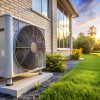When you decide to buy a new mattress there are plenty of factors that need to be considered. If the mattress is for an overweight person then the basic factors may remain the same but some additional factors need to be focused on. There are certain attributes that play a crucial role while buying a mattress for heavy people and ensure better sleep for them. Let us learn about some characteristics that will help you buy the right mattress.
Thickness of Mattress
Firstly and most importantly, thickness is very important when you decide to buy a mattress for an overweight person. Many people neglect this factor. For sleepers who weigh below 200 pounds a mattress of 10” is more than enough. For heavier ones, you should consider a mattress that has at least 12” thickness. The basic idea to look into thickness is to check for its deep compression support. If you are overweight and leave increased pressure on the sleeping mattress then the thinner mattresses will not offer the right kind of support that you need.
Some mattresses available with the thickness of 10” use modern foams which offer extra thick and comfortable layer or some other designs with advanced specifications that provide enhanced compression support can help them provide a better function for the overweight sleepers. Basically, it is always better to look for a premium Signature mattress with a perfect thickness as it will offer deep compression as well as consistent support in the long run. Deep compression support plus the thickness of the mattresses become extremely important for those who are overweight.
Edge Support is essential
While selecting the right mattress for overweight people make sure you do not overlook edge support. Mattresses are generally used while you sleep at night still play an important role for you during the day as well. If you are someone who loves throwing yourself on the bed often or completing different tasks sitting on the bed, then edge support is something you need to look at. When you are just sitting on the edge of your mattress it should be stable and strong so that it prevents sudden collapse even when you roll onto the edges while sleeping. You can get better edge support in mattresses made from hybrid designs, coil-on-coil, or springs. You may not find better edge support in mattresses made out of foam.
Firmness makes a difference
Deciding the firmness of a mattress entirely depends on the type of sleeper one is. If you are a heavy sleeper then the firmness should range from medium to medium on the firmness scale. Here again, your weight plays an important role as you may face a deeper sinkage and if you buy a softer mattress then it is again going to give you the same feeling. So firmness measurement is something that you need to consider if you are overweight.
Mattress should breathe
Some heavy sleepers often complain of sleeping hot which means the mattress that does not breathe or ventilate well during the night. When you add some additional sheets, kids, comforter, etc, you will find it so uncomfortable. If you are an overweight person more hair is produced so the mattress should breathe well. If the mattress doesn’t ventilate well you may feel uneasy and get up in the middle of the night in disturbed sleep.
Types
It is important to consider the type of mattress you want to buy for an overweight person. Some of the different types of mattresses available are
Latex
Latex mattresses are best known for perfect ventilation and durability. These two attributes are crucial for overweight sleepers.
Memory Foam
These mattresses are ideal for heavy sleepers as they offer better cradling support and if you decide to buy one check if it gels as it remains cool at night
Hybrid
This is advanced mattresses that are ideal for overweight people as it uses the combination of two different materials to make one. For instance, the top layer is a little springy and is durable because of latex, and has a spring base. It is quite affordable.
Innerspring
It is a feasible mattress for overweight people. It can be designed using various coil arrangements. It offers better edge support and ventilation too.
The above-mentioned factors can be helpful for you to determine the right kind of mattresses to be purchased for overweight people. When you have known what you need the decision would certainly be a smart decision. Above all durability and affordability does matter. Check if the product you want to buy is within your budget. Overweight people should buy mattresses that offer good support, comfort, and proper ventilation. Most mattresses give importance to ventilation, firmness, and comfort. They do not pay attention to the edge support which is equally important to avoid accidents while you fall asleep.
If you are an overweight person and looking out for the right mattress, then look for trusted companies that help you buy the right mattresses. The reliable companies often guide their customers on which mattress would be suitable for overweight people. Do not compromise on any of the factors stated above. Also, do not compromise on price as you may end up spending a little more but get all the features that you need. Sound sleep is important and so is your posture and comfort. Look for the mattress that meets your needs as an overweight person.
Many people believe that quality mattresses come for an expensive price but that is not always the case. The market is flooded with quality mattresses at an affordable price. Spend some time finding out what you need to invest in the right mattress. Many people spend most of their time even during the day in bed and they certainly need to look into how much time they are spending on their bed. A comfortable, ventilated, firm mattress with perfect edge support will give you an enjoyable experience of sound sleep. So go for something that suits your needs.






















